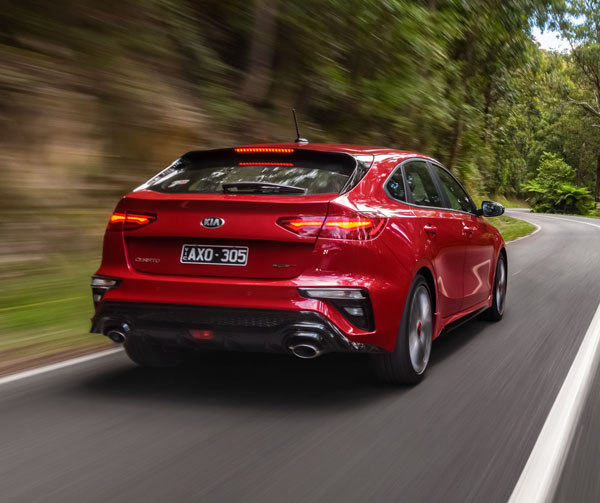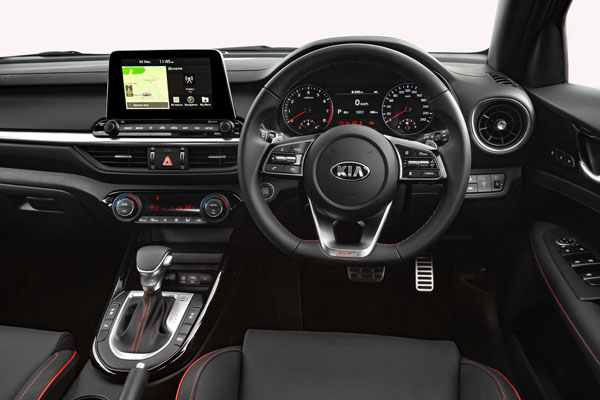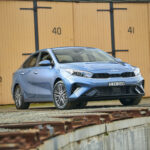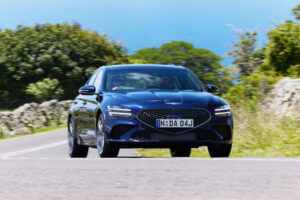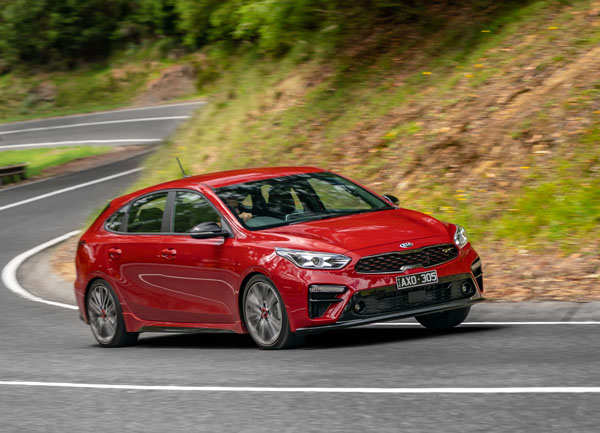
Kia continues its love affair unabated with ‘G’ and ‘T’ (No, not the alcoholic beverage, the sporty suffix). Hot on the heels of the Picanto GT and various GT-Line models, the Cerato came up with a ‘GT’ variant. Does it earn it?
Added to this is a multi-link independent rear suspension, the work of a local ride-and-handling team of engineers tasked with matching the car with Australia’s wide-ranging road surfaces.
Sport mapping added steering sharpness and weighting, as well as more precise shift points in Sport Mode, combine with a more aggressive suspension tune, larger ventilated front disc brakes and 18-inch alloy wheels, to offer above standard stopping performance.
“Australian drivers are like few others in the world,” says Kia Motors Australia Chief Operating Officer Damien Meredith. “They know what they like … and what they like is that rare combination of style, value and performance which doesn’t come along all that often.
“With the Cerato GT they have one additional opportunity to find what they are searching for and this time it is wearing a badge which comes with proven value and reliability.
“With a localisation program which had a clear focus on what the result was to be, the Cerato GT had to step up to the mark.”
The Cerato GT comes in sedan and hatchback form, selling for $32,990. The latter was the test vehicle.
STYLING
The Cerato GT is hard to miss with an aggressive look up front, leading to a clean profile with 18-inch alloy wheels and rear dominated by twin oval exhaust tips.
The Hatch is longer by 160 mm, wider by 20 mm and 10 mm lower than the standard hatchback yet sits on the same wheelbase. Overhangs are increased 20 mm at the front and 140 mm at the rear, resulting in more luggage space, up 43 litres to 428 litres.
INTERIOR
The Cerato GT features a stylish but no-nonsense cabin, highlights being leather upholstery with red stitching, a flat-bottomed, sporty steering wheel with a quality feel, alloy sports pedals, silver door handles and, soft-touch door trims.
Further cabin comfort features include climate control air-conditioning and ventilated front sport seats. The driver’s instrument cluster is simple, uncluttered and easy to read.
INFOTAINMENT
Infotainment is taken care of by an 8-inch touchscreen display, Apple CarPlay and Android Auto with voice recognition, wireless phone charger, eight-speaker JBL Premium sound system with Bluetooth connectivity.
ENGINES / TRANSMISSIONS
At the heart of the flagship is the four-cylinder 1.6-litre turbo-petrol engine producing 150 kW of power at 6000 rpm and 265 Nm of torque from a low 1500 to 4500 revs, driving the front wheels through a seven-speed double-clutch automatic transmission, with Sport mode.
SAFETY
The GT takes on all the active and passive safety systems of the Cerato range, winning a five-star ANCAP safety rating. These include autonomous emergency braking for pedestrian and cyclist, forward collision warning, lane keep assist, rear-view camera with dynamic guidelines, driver attention alert, front and rear parking sensors, drive mode select, six airbags, tyre pressure monitor, speed limiter, eight-way driver seat adjustment with two memory positions and smart cruise control.
DRIVING
A gruff ‘voice’ goes with the Cerato GT engine, especially with the motor accelerating or under load. However, at no time did the test car power train appear under excess strain. On the other hand, it’s not the hottest small motor around.
Indeed, engineers, who increased body stiffness for added safety and better handling in line with its sporty exterior, have delivered, with the exception of some intrusive engine noise at times, a quiet cabin environment.
With fuel consumption claimed by the maker to be 6.8 litres per 100 kilometres on the combined urban / highway cycle, the test vehicle used 10.6 litres per 100 kilometres on a daily commute. Cruising the motorway cut this to 5.3 litres per 100.
A Drive Mode system sets up the car with a range of characteristics from Eco to Smart, the latter I found fitted in best for everyday use. However, the going tended to be a bit bumpy on some of the neglected roads found in most Aussie cities. Not sure I would like to do a long country trip in one.
The local suspension tuning veers towards the stick-to-the-road stuff on fast bends, so beloved of Aussie drivers used to more expensive hot hatches than the Cerato GT.
Leg room in the rear has been sacrificed at the expense of footwell space for driver and front passenger, considered by Kia as being the more likely positions to be filled.
SUMMARY
Kia admits it was quite a balancing act to unite the sportiness of the Cerato GT platform, while still keeping the owner happy with driving in conditions normally found on a day-to-day basis. It’s not a perfect match but does much to deliver at an affordable fee.
MODEL A=RANGELINE-UP
Cerato Hatch GT: $32,990
Cerato Sedan GT: $32,990
Premium paint: $520
Note: These prices do not include government or dealer delivery charges. Contact your local Kia dealer for drive-away prices.
SPECIFICATIONS (Kia Cerato GT 1.6L Turbo 4-cylinder petrol, 7sp automatic, 5dr hatchback)
ENGINE:
Capacity: 1.591 litres
Configuration: Four cylinders in line
Maximum Power: 150 kW @ 6000 rpm
Maximum Torque: 265 Nm @ 1500-4500 rpm
Fuel Type: Petrol 91 RON
Combined Fuel Cycle (ADR 81/02): 6.8 L/100km
CO2 Emissions: 158 g / km
DRIVELINE: Seven-speed dual clutch automatic with Sport Mode
DIMENSIONS, WEIGHT AND CAPACITIES:
Length: 4510 mm
Wheelbase: 2700 mm
Width: 1800 mm
Height: 1440 mm
Turning Circle: 10.6 metres
Tare weight: 1395 kg
Fuel Tank Capacity: 50 litres
BRAKES:
Front: Ventilated disc
Rear: Solid disc
STANDARD WARRANTY:
Seven years / unlimited kilometres




